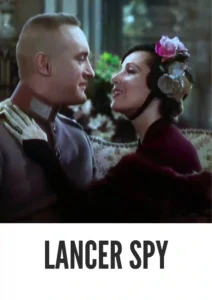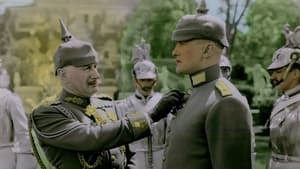Video Sources 0 Views
- Lancer Spy 1937 Colorized


Synopsis
Table of Contents
ToggleDouble Agents and Political Intrigue: Lancer Spy (1937) in Vivid Color

Experience the suspense of Lancer Spy, a gripping espionage thriller from 1937, now beautifully colorized for a modern audience. Starring Peter Lorre and Dolores del Río, this film delivers a complex web of deceit, danger, and political maneuvering during the volatile pre-World War II era. Perfect for fans of classic thrillers and historical dramas, this HD download brings a stylish and intense piece of cinematic history to your screen. It is also known as La Espía Lancero.
Lancer Spy Storyline: A World of Deception and Intrigue
Lancer Spy plunges into the shadowy world of espionage as a British officer, disguised as a German aristocrat, navigates the treacherous landscape of pre-war Europe. Major Michael Bruce (George Sanders), uses his remarkable resemblance to Baron von Rohrbach to infiltrate high society and gather intelligence for the British.His mission becomes increasingly complicated when he encounters Dolores del Río, a captivating woman with her own secrets and allegiances. As Bruce delves deeper into his dangerous charade, he uncovers a network of spies, double agents, and ruthless adversaries, including the sinister Peter Lorre as the ever-watchful and menacing Gestapo agent. The film builds to a climactic confrontation where Bruce must use all his cunning and skill to expose a plot that could alter the course of history. Lancer Spy is a thrilling tale of deception and bravery set against the backdrop of a world on the brink of war.
Movie Cast
- George Sanders as Major Michael Bruce / Baron von Rohrbach
- Dolores del Río as Dolores Daria
- Peter Lorre as Gestapo Agent
- Joseph Schildkraut as Col. Wilhelm Von Remer
- Sig Ruman as Gen. Kurt Von Seeckt
Movie Genre
Lancer Spy is best described as an espionage thriller, blending elements of suspense, political intrigue, and historical drama. Set against the backdrop of pre-World War II Europe, the film offers a stylish and atmospheric portrayal of a world on the brink of conflict.
Historical Context: Hollywood and the Shadow of War
Released in 1937, Lancer Spy reflects the growing anxieties and political tensions of the pre-World War II era. Hollywood films of this period often grappled with themes of espionage, political intrigue, and the looming threat of global conflict. Lancer Spy stands out for its stylish production values, engaging performances, and its willingness to explore the complexities of identity, loyalty, and deception in a world on the brink of war.
Colorization Details
This colorized version of Lancer Spy has been meticulously restored using modern digital techniques, enhancing the visual appeal while preserving the film’s original atmosphere. The colorization process involved carefully analyzing the grayscale tones of the original black and white footage and assigning appropriate colors to each scene. While the specific software used remains proprietary, the techniques employed included advanced algorithms for color palette selection and image enhancement. This painstaking process brings new life to the characters and settings, making the story even more engaging for modern audiences. While some may debate the merits of colorizing classic films, it introduces these films to a broader audience, ensuring their legacy for future generations.
Technical Details
- Director: Gregory Ratoff
- Screenplay: Philip Dunne
- Story: Martha Albrand
- Cinematography: Arthur C. Miller
- Edited by: Allen McNeil
- Production Company: Twentieth Century Fox
- Distributed by: Twentieth Century Fox
- Runtime: 85 minutes
Technical Specifications
- Download Format: MP4
- Resolution: HD (1080p)
- Compatibility: Compatible with most devices, including smartphones, tablets, computers, and smart TVs.
Reviews and Critical Reception
Lancer Spy (1937) is a stylish and suspenseful espionage thriller that showcases strong performances from its cast, particularly Peter Lorre and Dolores del Río. The film is praised for its atmospheric cinematography, intricate plot, and its ability to capture the political tensions of pre-war Europe. Lancer Spy remains a compelling example of classic Hollywood filmmaking.
FAQs
- Q: What is Lancer Spy about?
- A: Lancer Spy is an espionage thriller about a British officer who impersonates a German aristocrat to gather intelligence before World War II.
- Q: Is Lancer Spy (1937) a well-known film?
- A: While not as widely recognized as some classic thrillers, Lancer Spy is a well-regarded example of the genre.
- Q: Is this version of Lancer Spy colorized?
- A: Yes, this version has been professionally colorized to enhance the viewing experience.
- Q: What makes Lancer Spy interesting for classic film fans?
- A: Lancer Spy offers a glimpse into the world of espionage during the volatile pre-war era, featuring strong performances and a compelling story.
- Q: What is the download format?
- A: The download format is MP4, which is compatible with most devices.
- Q: What resolution is the download?
- A: The resolution is HD (1080p), providing a high-quality viewing experience.
Download Now in HD!
Watch Lancer Spy Today!











